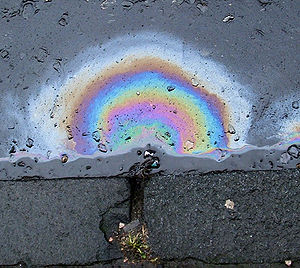- Thin-film optics
-
 Dichroic filters are created using thin film optics.
Dichroic filters are created using thin film optics.
 A pattern of coloured light formed by interference between white light being reflected from the surface of a thin film of diesel fuel on the surface of water, and the diesel-water interface.
A pattern of coloured light formed by interference between white light being reflected from the surface of a thin film of diesel fuel on the surface of water, and the diesel-water interface.
Thin-film optics is the branch of optics that deals with very thin structured layers of different materials. In order to exhibit thin-film optics, the thickness of the layers of material must be on the order of the wavelengths of visible light (about 500 nm). Layers at this scale can have remarkable reflective properties due to light wave interference and the difference in refractive index between the layers, the air, and the substrate. These effects alter the way the optic reflects and transmits light. This effect, known as thin-film interference, is observable in soap bubbles and oil slicks.
More general periodic structures, not limited to planar layers, are known as photonic crystals.
In manufacturing, thin film layers can be achieved through the deposition of one or more thin layers of material onto a substrate (usually glass). This is most often done using a physical vapor deposition process, such as evaporation or sputter deposition, or a chemical process such as chemical vapor deposition.
Thin films are used to create optical coatings. Examples include low emissivity panes of glass for houses and cars, anti-reflective coatings on glasses, reflective baffles on car headlights, and for high precision optical filters and mirrors. Another application of these coatings is spatial filtering.[1]
Thin-film layers are common in the natural world. Their effects produce colors seen in soap bubbles and oil slicks, as well as in some animals. For example, the light collecting tapetum lucidum of many nocturnal species and the photophores of bioluminescent squid (e.g., the Bobtail squid). In many cases, iridescent colors that were once thought to result from planar layers, such as in opals, peacocks, and the Blue Morpho butterfly, turn out to result from more complex periodic photonic-crystal structures.
See also
- Dichroic filter
- Dichroic prism
- Dielectric mirror
- Fresnel equations
- Thin-film interference
- Transparent materials
- Dual polarisation interferometry
References
- ^ Moreno, Ivan; Araiza, JJ; Avendano-Alejo, M (2005). "Thin-film spatial filters". Optics Letters 30 (8): 914–6. Bibcode 2005OptL...30..914M. doi:10.1364/OL.30.000914. PMID 15865397.
Further reading
- M. F. Land (1972). "The physics and biology of animal reflectors," Progress in Biophysics and Molecular Biology, 24:75–106. doi:10.1016/0079-6107(72)90004-1 . An excellent introduction to thin-film optics, with a focus on biology. Cites more rigorous treatments.
- Z. Knittl: Optics of thin films, Wiley, 1981.
- I. Moreno, et al., "Thin-film spatial filters," Optics Letters 30, 914–916 (2005)
- MacLeod, H. Angus (2010). Thin-Film Optical Filters, Fourth Edition. Taylor & Francis. ISBN 978-142-007-302-7.
Categories:
Wikimedia Foundation. 2010.
